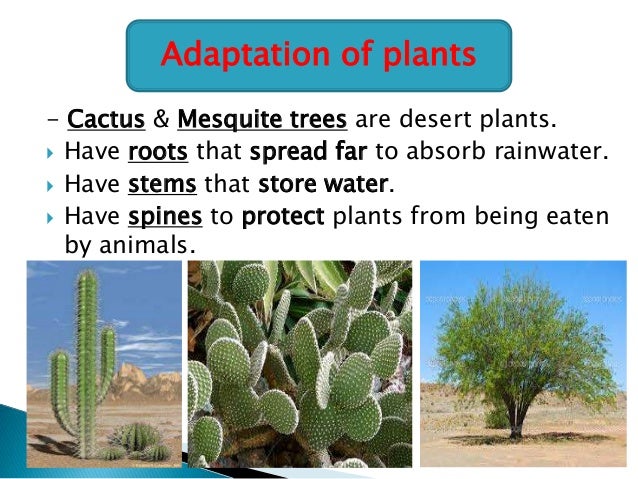40 Animal And Plant Adaptations In The Desert
Then they use their long tongues to get into ant and termite mounds. Desert snakes and lizards hibernate 05 m or more in sand under rocks or in burrows of other animals.
Thick and tough lips help them to pick at dry and thorny desert plants.
Animal and plant adaptations in the desert. Animals like the golden eagle and peregrine falcon can reach speeds. The plants in the Desert biome store water in their roots stem leaves or fruit. The best and the biggest channel for science videos for kidsFor Kindergartenpreschoolers primary school kids.
Although most think of birds when it comes to wings other animals like the vampire bat also have wing-like structures that help it fly. They also may shiver to generate additional heat. Plant Adaptations Penguins rearrange their feathers by preening.
Stem Adaptations in Desert Plants. Plants called succulents store water in. Deserts Biomes have harsh weather - Very hot.
Ephemeral annuals are also called as drought evaders or drought escapers. A ephemeral annuals b succulents and c desert shrubs. Stems of most cacti and other succulents are thick and fleshy.
Of course the primary function of wings is flight in most animals with wings. Desert Plants Adaptation Projects Animal Adaptations Projects Desert Biome Primary Science Animal Habitats Plant Science Animal Adaptations Desert Animals Adaptations. There are three life-forms of plants that are adapted to desert ecosystem.
Broad and flat feet so they dont sink in the sand and walk easily. Protection of eye ear and. The root system is highly developed for water absorption.
Plant adaptations in the desert rainforest and tundra allow plants and trees to sustain life. Saved by Pima Community College Career Services. This species typically grows in.
Thick waxy skin to reduce loss of water and to reflect heat. A Adaptations of desert plants and animals- 1. Sage Bushes Creosote Bushes Cacti Lupine Indian Paintbrush Prickly Poppies Chia Ghost Flower Desert Chickory Prickly Pears Dragon Trees Desert Spoons.
Thick and Fleshy Stems. The stems of desert plants also exhibit various specializations that allow them to thrive in harsh desert climates. Adaptations can include such traits as narrow leaves waxy surfaces sharp spines and specialized root systems.
Echidna are found in the deserts of Australia and also have unique adaptations. Adaptations help desert animals to acquire and retain water and to regulate body temperatures which helps them to survive in the harsh conditions of the desert. PLANT AND ANIMAL ADAPTATIONS TO THE DESERT.
Stems Perform the Function of Leaves. Thorns and thin spiky or glossy leaves to reduce water loss. Deep roots to tap groundwater.
Plant and Animal Adaptations मरसथल परसथतक ततरHindi Documentary. Their long nose helps them locate food by sensing the electrical movements created by ants and termites. Long shallow roots which.
They germinate grow flower and release seeds within the. Plant Adaptations in the Desert Biome In order for plants to survive in the desert they have adaptations that allow them to collect and store water and moisture and prevent moisture loss. Desert Ecosystem Plant Adaptations.
The desert larkspur Delphinium parryi is a plant species that employs this drought-evasion adaptation by only sprouting during wet years. Examples of Plants found in the Desert. Such stems hold moisture that helps the plant survive drought.
Spikes protect cacti from animals wishing to use stored water. Plants have evolved many adaptions for surviving the rigors of the desert. They can go for a week or more without water.
Large fleshy stems to store water. Plant and animal bodies are made up of a number of complex biological processes which take place within a narrow range of temperatures. To conserve heat penguins may tuck in their flippers close to their bodies.
Polar bears live in one of the planets coldest environments and depend on a thick coat of insulated fur which covers a warming layer of fat. Burrows of kangaroo rat penetrate 50-65 cm below the surface. Some ants and crickets burrow deeply into the ground.
Wings are another highly visible adaptation on many animals. Animal Adaptations in the Desert Biome Animals of the desert need to adapt to intense heat and lack of water and shelters. Plant populations co-evolve characteristics that are uniquely tailored to their environment.
In the desert the plants are succulent and store water in fleshy leaves stems or roots.

